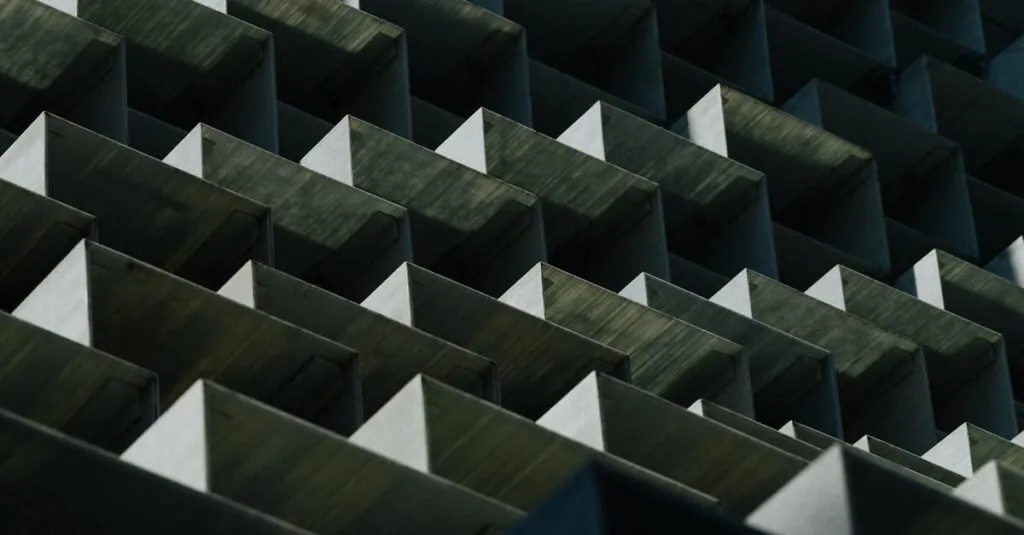Table of Contents
ToggleIn the ever-evolving world of blockchain, modular design is the shiny new toy everyone wants to play with. Imagine a blockchain that’s as flexible as a yoga instructor and as efficient as a coffee-fueled coder. Modular blockchain design breaks the traditional mold, allowing developers to mix and match components like a kid in a candy store.
This innovative approach not only boosts scalability but also enhances customization, making it easier to adapt to the unique needs of different applications. Think of it as building your own burger—pick your patty, add some toppings, and voilà! With modular blockchain, the possibilities are endless. Get ready to dive into a world where flexibility meets functionality, and discover why this design is the future of decentralized technology.
Overview of Modular Blockchain Design
Modular blockchain design emphasizes the ability to adapt systems based on specific needs. This approach allows developers to select various modules, such as consensus mechanisms and smart contract platforms, thereby tailoring the blockchain environment. Each module can function independently, enhancing the overall efficiency of the blockchain network.
Scalability represents a critical advantage of this design. By assigning different modules to specialized tasks, networks can manage larger transaction volumes. Developers can focus on improving specific functions without overhauling the entire system.
Customization stands out as another significant benefit. Projects can evolve without disruptive changes, accommodating new features or adjustments as market demands shift. Developers can meet the unique requirements of applications effectively.
Security also plays a vital role in this design framework. With isolated modules, security enhancements can occur in specific areas without impacting others. This feature lowers vulnerability risks, strengthening the entire network’s integrity.
Interoperability is another essential component. Various modules can communicate across different blockchain platforms, increasing collaboration possibilities. Developers can integrate innovative solutions from multiple ecosystems seamlessly.
Data management benefits significantly from modular design. Efficient handling of information across various modules can improve transaction speeds and reduce latency. This aspect enhances user experience and fosters trust in the network.
Modular blockchain design represents a transformative approach to decentralized technology. Flexibility, scalability, customization, security, interoperability, and improved data management come together to create a more robust blockchain environment for developers.
Key Components of Modular Blockchain Design
Modular blockchain design comprises several integral components that enhance its functionality and adaptability. Understanding these key elements allows for a deeper appreciation of its capabilities.
Layered Architecture
Layered architecture serves as the foundation for modular blockchain design. This structure enables separation of various functions, allowing independent development of each layer. Each layer targets specific tasks, such as consensus or data storage. By compartmentalizing functions, scalability improves since modifications to one layer avoid disruptions to others. Additionally, this approach fosters the integration of diverse technologies, which can optimize performance and user experience. As a result, developers can leverage this architecture for tailored solutions, meeting unique requirements within decentralized applications.
Interoperability Solutions
Interoperability solutions play a crucial role in modular blockchain design. These solutions facilitate communication between different blockchain networks, enabling seamless data exchange. This interconnectedness breaks down silos that often hinder collaboration among platforms. Each network benefits from enhanced functionality, allowing developers to draw on the strengths of multiple blockchains. With robust interoperability, projects can expand their reach, creating richer ecosystems. Moreover, it empowers users by providing access to diverse services regardless of the underlying blockchain. Achieving interoperability paves the way for a more integrated future in decentralized technology.
Benefits of Modular Blockchain Design
Modular blockchain design offers numerous advantages that make it a compelling choice for developers and organizations. Enhanced scalability and flexibility are among its key benefits.
Scalability Improvements
Scalability improvements stand out as a primary benefit of modular blockchain designs. Systems can efficiently handle increased transaction volumes by separating functions into distinct layers. This architecture allows networks to focus on optimizing specific tasks, thus improving overall performance. For instance, if one module experiences a surge in demand, it can be upgraded independently without affecting the entire network. Transaction throughput significantly increases, enabling a more seamless user experience. Greater efficiency reduces bottlenecks, which often plague traditional blockchain systems. With better scalability, applications can support a larger number of users and transactions, fostering growth and innovation in blockchain technology.
Enhanced Flexibility
Enhanced flexibility is another vital advantage of modular blockchain design. Developers can select and integrate various modules, tailoring solutions to their specific needs. Customizable components allow for unique consensus mechanisms or smart contract platforms to fit varying use cases. Opting for a modular architecture fosters rapid adaptation to changing technological landscapes. Each module functions independently, making it simple to introduce new features or optimize existing ones without disrupting the whole system. As a result, projects can evolve smoothly, responding to user feedback and market demands without extensive overhauls. This flexibility not only accelerates development cycles but also encourages experimentation, ultimately driving innovation within decentralized applications.
Challenges and Considerations
Modular blockchain design presents unique challenges that developers must address. These challenges primarily involve security and governance.
Security Concerns
Security remains a top priority in modular blockchain design. Isolated modules may become targets for attacks, as vulnerabilities in one module can compromise the entire system. Ensuring robust security measures, such as rigorous testing and audits, becomes essential. Furthermore, dependencies between modules complicate risk management, increasing the need for comprehensive oversight. Developers must implement clear protocols to detect and respond to security threats swiftly.
Governance Issues
Governance poses significant challenges in modular blockchain ecosystems. Diverse stakeholders may participate, leading to potential conflicts over decision-making processes. Clear frameworks that define roles and responsibilities among participants are crucial for maintaining order. Additionally, balancing the interests of various entities can prove problematic, particularly when change is required. Implementing effective governance models strengthens collaboration and encourages participation, ensuring that modular designs meet evolving expectations.
Modular blockchain design stands out as a revolutionary approach that empowers developers with unparalleled flexibility and scalability. By allowing the selection of specific modules tailored to unique project requirements, it fosters innovation and adaptability in decentralized applications.
As the technology continues to evolve, the importance of addressing security and governance challenges cannot be overstated. Robust measures and clear frameworks will be essential in ensuring that the benefits of modular design are fully realized.
Ultimately, this approach not only enhances user experience but also paves the way for a more connected and efficient blockchain ecosystem. The future of decentralized technology looks promising with modular blockchain design leading the charge.







